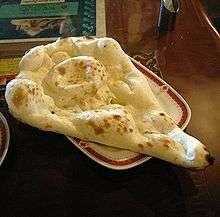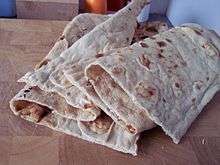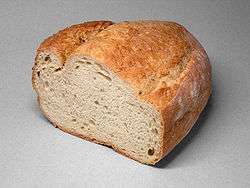Paratha
|
Potato paratha (aloo paratha) from India | |
| Alternative names | Paratha, parauntha, palata, farata, parontay, prontha |
|---|---|
| Region or state | Indian Subcontinent |
| Main ingredients | Atta, maida, ghee/butter/cooking oil and various stuffings |
|
| |
A paratha is a flatbread that originated in the Indian subcontinent. It is still prevalent throughout Pakistan and India, where wheat is grown and is the traditional staple of the area. Paratha is an amalgamation of the words parat and atta which literally means layers of cooked dough.[1] Alternative spellings and names include parantha, forota (in Sylheti), parauntha, prontha, parontay, porota (in Bengali), palata (pronounced: [pəlàtà]; in Burma), and farata (in Mauritius, Sri Lanka and the Maldives).
History
Recipes for various stuffed wheat parathas are mentioned in Manasollasa, a 12th-century Sanskrit encyclopedia compiled by Someshvara III, who ruled from present-day Karnataka.[2]
Plain parathas and stuffed parathas
| Nutritional value per 100 g (3.5 oz) | |
|---|---|
|
45.36 g | |
| Sugars | 4.15 |
| Dietary fiber | 9.6 g |
|
13.20 g | |
|
6.36 g | |
| Vitamins | |
| Thiamine (B1) |
(10%) 0.11 mg |
| Riboflavin (B2) |
(6%) 0.076 mg |
| Niacin (B3) |
(12%) 1.830 mg |
| Pantothenic acid (B5) |
(0%) 0 mg |
| Vitamin B6 |
(6%) 0.08 mg |
| Folate (B9) |
(0%) 0 μg |
| Vitamin E |
(9%) 1.35 mg |
| Vitamin K |
(3%) 3.4 μg |
| Minerals | |
| Calcium |
(3%) 25 mg |
| Iron |
(12%) 1.61 mg |
| Magnesium |
(10%) 37 mg |
| Phosphorus |
(17%) 120 mg |
| Potassium |
(3%) 139 mg |
| Sodium |
(30%) 452 mg |
| Zinc |
(9%) 0.82 mg |
| Other constituents | |
| Water | 33.5 g |
|
| |
| |
|
Percentages are roughly approximated using US recommendations for adults. Source: USDA Nutrient Database | |
Parathas are one of the most popular unleavened flatbreads in the India part of the Indian Subcontinent and they are made by baking whole wheat dough on a tava, and finishing off with shallow frying.[3] Parathas are thicker and more substantial than chapatis/rotis and this is either because, in the case of a plain paratha, they have been layered by coating with ghee or oil and folding repeatedly (much like the method used for puff pastry or some types of Turkish börek) using a laminated dough technique; or else because food ingredients such as mixed vegetables have been mixed in with the dough, such as potato and/or cauliflower, green beans and carrots. A Rajasthani mung bean paratha uses both the layering technique together with mung dal mixed into the dough, while some so called stuffed parathas resemble a filled pie squashed flat and shallow fried using two discs of dough sealed round the edges; alternatively using a single disc of dough to encase a ball of filling and sealed with a series of pleats pinched into the dough round the top, gently flattened with the palm against the working surface before being rolled into a circle. Most stuffed parathas are not layered.
Parathas can be eaten as a breakfast dish or as a tea-time (tiffin) snack. The flour used is finely ground wholemeal (atta) and the dough is shallow fried.
Perhaps the most common stuffing for parathas is mashed, spiced potatoes (aloo ka parantha) followed perhaps by dal (lentils). 'Many other alternatives exist such as leaf vegetables, radishes, cauliflower, and/or paneer. A paratha (especially a stuffed one) can be eaten simply with a pat of butter spread on top or with chutney, pickles, ketchup, dahi or a raita or with meat or vegetable curries. Some roll the paratha into a tube and eat it with tea, often dipping the paratha.
To achieve the layered dough for plain parathas, a number of different traditional techniques exist. These include covering the thinly rolled out pastry with oil, folding back and forth like a paper fan and coiling the resulting strip into a round shape before rolling flat, baking on the tava and shallow frying. Another method is to cut a circle of dough from the centre to its circumference along its radius, oiling the dough and starting at the cut edge rolling so as to form a cone which is then squashed into a disc shape and rolled out. The method of oiling and repeatedly folding the dough as in western puff pastry also exists, and this is combined with folding patterns that give traditional geometrical shapes to the finished parathas. Plain parathas can be round, heptagonal, square, or triangular.
Serving
The paratha is an important part of a traditional South Asian breakfast. Traditionally, it is made using ghee but oil is also used. Some people may even bake it in the oven for health reasons. Usually the paratha is eaten with dollops of white butter on top of it. Side dishes which go very well with paratha are curd, fried egg, omelette, qeema (ground mutton cooked with vegetables and spices), nihari (a lamb dish), jeera aloo (potatoes lightly fried with cumin seeds), daal, and raita as part of a breakfast meal. It may be stuffed with potatoes, paneer, onions, qeema or chili peppers.
Types
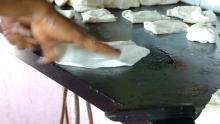
- Ajwain paratha (layered paratha laced with ajwain)
- Aloo paratha (stuffed with spicy boiled potato and onions mix)
- Aloo cheese paratha
- Anda paratha (stuffed with spiced egg)
- Bal wala paratha
- Band gobi wala paratha/Patta gobhi paratha (stuffed with cabbage)
- Batuha paratha (Lamb's quarter, Chenopodium album)
- Boondi paratha (stuffed with salty boondi & baked with ghee)
- Ceylon paratha (from Sri Lanka)
- Chana paratha (chick peas)
- Channa dal paratha (stuffed with channa dal)
- Chicken paratha
- Chili parotha/mirchi paratha (small, spicy shredded pieces)
- Dal paratha (stuffed with boiled, spiced and mashed dal mostly available in northwestern and western India)
- Dhakai paratha (a type of layered paratha found in West Bengal)
- Dhaniya paratha (coriander)
- Gajar paratha (carrot)
- Gobhi paratha (stuffed with flavoured cauliflower)
- Jaipuri paratha
- Kerala paratha (popular version pronounced "porotta")
- Lachha paratha – tandoori (Punjabi in origin. Round in shape with multiple layers traditionally prepared in a tandoor)
- Lachha paratha – tawa wali (popular in eastern India, triangular in shape with multiple layers interspaced with ghee)
- Lasuni Paratha (Garlic flavoured)
- Lauki paratha (bottle gourd)
- Makka paratha (corn)
- Mattar paratha (stuffed with boiled, mashed and flavoured green peas)
- Meetha paratha (stuffed with sugar)
- Methi paratha (stuffed with fenugreek leaves)
- Mooli paratha (radish-stuffed paratha, popular in most regions of northern India and the Punjab region of India.)
- Mughlai paratha (a deep fried stuffed paratha filled with egg and minced meat)
- Mutton paratha
- Papeetey ka paratha (papaya stuffed paratha)
- Mix paratha
- Palak paratha (spinach)
- Paneer paratha (stuffed with cottage cheese)
- Papad parantha
- Parton wala paratha ( Lachha paratha )
- Petai paratha (Smashed paratha)
- Plain paratha (layered roti without any stuffing except ghee and baked with ghee – popular in most regions of India)
- Podeena paratha (laced with dry mint)
- Putthay taway ka paratha
- Pyaz ka paratha (stuffed with onion)
- Qeema paratha, (stuffed with minced meat (keema), usually mutton, mostly available in Punjab, Hyderabad in India, and Myanmar)
- Roti paratha/prata (Singapore & Malaysia)
- Sattu paratha (stuffed with spiced sattu – roasted gram flour popular in Uttar Pradesh and Bihar)
- Shrimp paratha
- Sugar paratha (layered with caramelized sugar, usually after a meal or as dessert)
- Tandoori paratha
- Tomato paratha (stuffed with tomatoes)
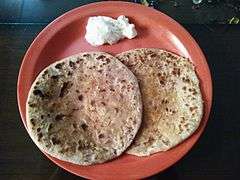 Aloo Paratha served with Butter, from India
Aloo Paratha served with Butter, from India- Dhakai Paratha, from West Bengal, India
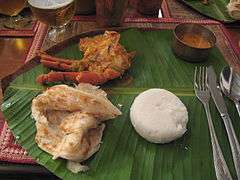 Mangalorean-style paratha served with other Indian dishes
Mangalorean-style paratha served with other Indian dishes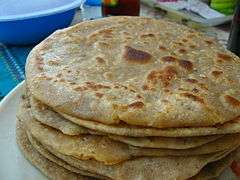 Aloo paratha from northern India
Aloo paratha from northern India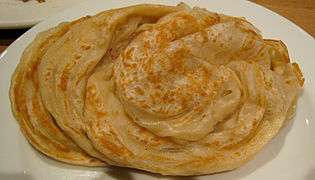 South Indian parotta
South Indian parotta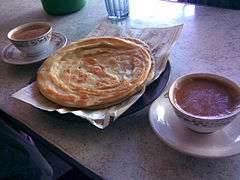 Paratha served with tea in a Pakistani Hotel
Paratha served with tea in a Pakistani Hotel
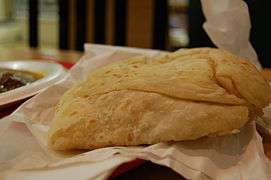 Trinidadian-style roti paratha
Trinidadian-style roti paratha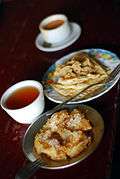 In Burma, paratha is commonly eaten as a dessert, sprinkled with sugar
In Burma, paratha is commonly eaten as a dessert, sprinkled with sugar- Petai Paratha (Smashed Paratha), a West Bengal variant served with light vegetable curry
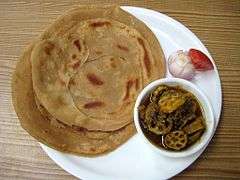 Lachha Paratha
Lachha Paratha_as_served_in_Tamil_Nadu%2C_India.jpg) Kothu Parotta (Chicken) as served in Tamil Nadu, India
Kothu Parotta (Chicken) as served in Tamil Nadu, India
Ready-made varieties
The process of layering the "skins" of dough in a parantha can make preparation a difficult process. This, mixed with the popularity of this flatbread, has opened the market to several ranges of frozen parantha, especially in Western markets where consumers seek authenticity, but lack the time or the skills required to make a parantha from scratch. Ready-to-cook parantha may also be purchased. These preparations offer one-step preparation and save time. Some of the ready-to-cook products in the market are just the stuffings for making the stuffed paranthas.
See also
- Bhatura
- Chili parotha
- Gali Paranthe Wali
- Green onion pancake (Chinese variant)
- Kerala porotta
- Kothu parotta, the South Indian variant
- Naan
- Parotta
- List of bread dishes
- List of Indian breads
References
- ↑ Mughlai Cook Book - By Neera Verma
- ↑ K.T. Achaya (2003). The Story of Our Food. Universities Press. p. 85. ISBN 978-81-7371-293-7.
- ↑ Climbing the Mango Trees - By Madhur Jaffrey
External links
| Wikimedia Commons has media related to Paratha. |

